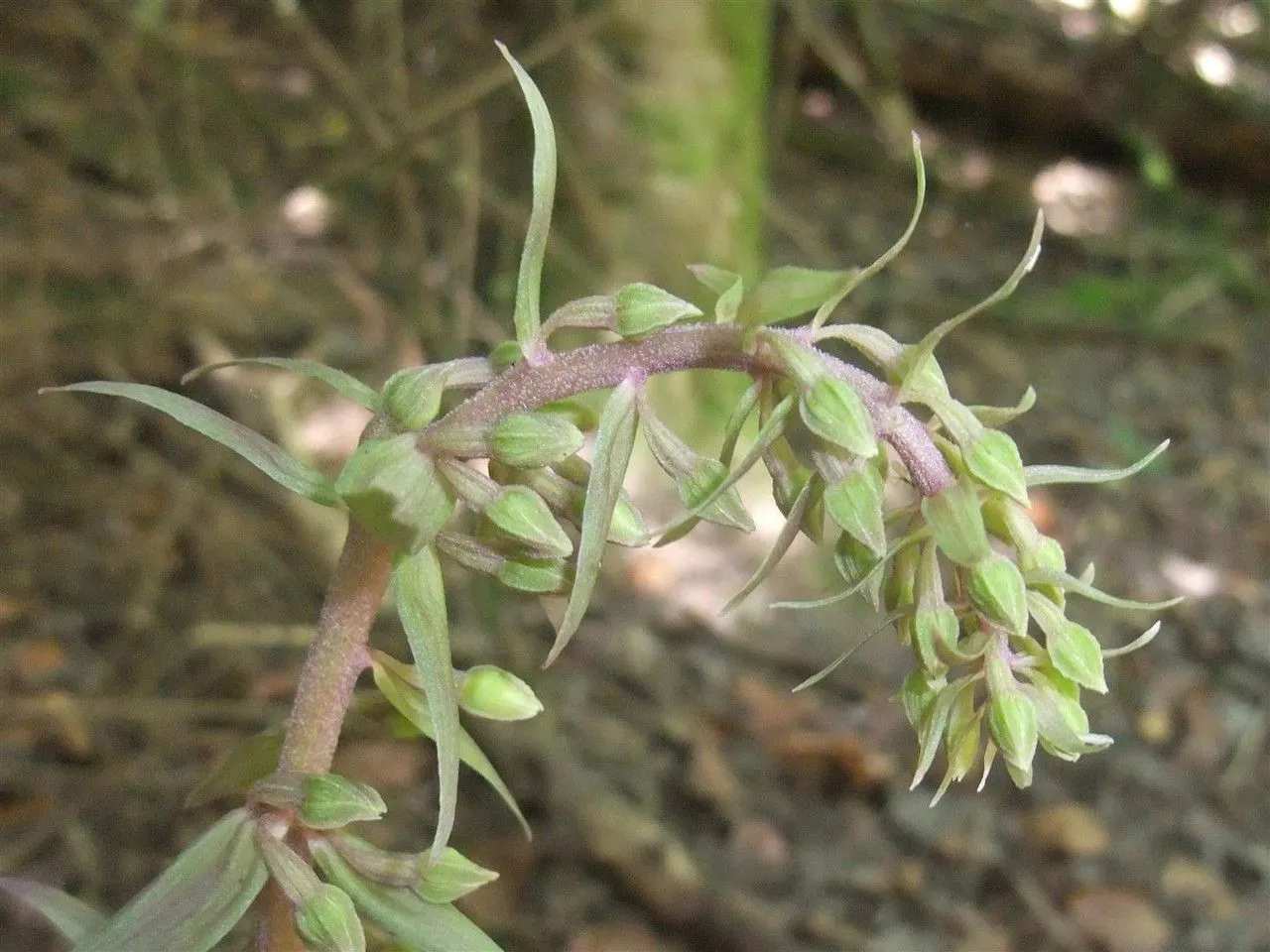
Author: Sm.
Bibliography: Engl. Fl. 4: 41 (1828)
Year: 1828
Status: accepted
Rank: species
Genus: Epipactis
Vegetable: False
Observations: Europe to N. Iran
The Violet Helleborine, scientifically known as Epipactis purpurata, is a captivating orchid species belonging to the Orchidaceae family. First described by the botanist Sm. in the early 19th century, with its initial documentation appearing in “Engl. Fl. 4: 41” in 1828, this plant has intrigued botanists and horticulturists alike for centuries.
Epipactis purpurata is native to a broad region stretching across Europe and extending into Northern Iran. This widespread distribution showcases the plant’s adaptability to a variety of climatic conditions and habitats. Typically found in shaded woodland areas, the Violet Helleborine thrives in environments that provide a mixture of dappled sunlight and moist, well-drained soils rich in organic material.
The plant is particularly admired for its striking appearance. The leaves are typically a deep, lush green, setting off the rich purplish hues of its flowers. The inflorescence of the Violet Helleborine is a raceme, comprised of multiple small blossoms that captivate observers with their subtle, yet intricate beauty. Each flower exhibits a palette of soft green and violet shades, often with some variations that may incline more towards either tone, depending on the specific environmental conditions and genetic variations within populations.
Beyond its aesthetic appeal, Epipactis purpurata plays a vital role in its native ecosystems. As with other members of the orchid family, it forms symbiotic relationships with mycorrhizal fungi, which are crucial for the plant’s nutrient uptake and overall health. This intricate biological interplay not only exemplifies the complexity of ecological networks but also underscores the importance of preserving natural habitats to maintain such relationships.
Observations of the Violet Helleborine indicate that while it is relatively widespread, its populations may be impacted by factors such as deforestation, habitat fragmentation, and climate change. Conservation efforts are essential to ensure that this elegant orchid continues to flourish in the wild, allowing future generations to appreciate its beauty and ecological significance.
In conclusion, the Violet Helleborine is a remarkable species with a rich botanical history and a vital role in its ecosystem. Its distinct appearance and complex ecological interactions make it a subject of ongoing fascination and study within the botanical community.
Deu: purpurrote sumpfwurz, violette stendelwurz
Dan: tætblomstret hullæbe
Swe: mångblommig knipprot
Eng: violet helleborine
Nob: purpurflangre
Nno: purpurflangre
Cym: caldrist porffor, y galdrist ruddlas
En: Violet Helleborine, Violet Hellebrine
Hr: Ljubičasta kruščika
Cs: Kruštík modrofialový
Da: Tætblomstret Hullæbe
Nl: Paarse wespenorchis
Fi: Purppuraneidonvaippa
Fr: Épipactis violacé, Épipactis pourpre, Épipactis pourprée, Épipactis violacée, Elléborine pourpre, Helléborine pourpre
De: Violette Stendelwurz, Purpurrote Sumpfwurz, Purpur-Stendelwurz, Violette Sumpfwurz, Violettrote Sumpfwurz
Hu: Ibolyás nőszőfű
It: Elleborina purpurea, Elleborine purpurea
Lt: Trumpalapis skiautalūpis
No: Purpurflangre
Nb: Purpurflangre
Nn: Purpurflangre
Pl: Kruszczyk siny
Es: Heleborina púrpura
Sv: Mångblommig knipprot
Uk: Коручка пурпурова
Cy: Y galdrist ruddlas, Caldrist Porffor
: Violet helleborine
Taken Aug 7, 2016 by Tela Botanica − Yoan MARTIN (cc-by-sa)
Taken Aug 7, 2016 by Tela Botanica − Yoan MARTIN (cc-by-sa)
Taken Aug 7, 2016 by Tela Botanica − Yoan MARTIN (cc-by-sa)
Taken Aug 7, 2016 by Tela Botanica − Yoan MARTIN (cc-by-sa)
Taken Aug 7, 2016 by Tela Botanica − Yoan MARTIN (cc-by-sa)
Taken Jul 15, 2006 by Photoflora – Bernard TILLY (©)
Taken Jul 16, 2019 by Jürgen Jürgenson (cc-by-sa)
Taken Sep 20, 2008 by Martin Bishop (cc-by-sa)
Taken Aug 28, 2013 by Tela Botanica − Hugues TINGUY (cc-by-sa)
Taken Jan 1, 1800 by Tela Botanica − Thierry Pernot (cc-by-sa)
Taken Jan 1, 1800 by Tela Botanica − Thierry Pernot (cc-by-sa)
Taken Aug 3, 2010 by Tela Botanica − Michel CANTAGREL (cc-by-sa)
Taken Aug 7, 2016 by Tela Botanica − Yoan MARTIN (cc-by-sa)
Taken Sep 20, 2008 by Martin Bishop (cc-by-sa)
Taken Aug 15, 2005 by Photoflora – Jean-Luc TASSET (©)
Taken Jan 1, 1800 by Tela Botanica − Thierry Pernot (cc-by-sa)
Taken Aug 7, 2016 by Tela Botanica − Yoan MARTIN (cc-by-sa)
Taken Aug 7, 2016 by Tela Botanica − Yoan MARTIN (cc-by-sa)
Taken Aug 7, 2016 by Tela Botanica − Yoan MARTIN (cc-by-sa)
Taken Aug 7, 2016 by Tela Botanica − Yoan MARTIN (cc-by-sa)
Taken Aug 7, 2016 by Tela Botanica − Yoan MARTIN (cc-by-sa)
Taken Jul 15, 2019 by Photoflora – Benoit BOCK (©)
Taken Jul 15, 2019 by Photoflora – Benoit BOCK (©)
Taken Jul 15, 2019 by Photoflora – Benoit BOCK (©)
Taken Jul 15, 1996 by Photoflora – Benoit BOCK (©)
Taken Jul 15, 1996 by Photoflora – Benoit BOCK (©)
© copyright of the Board of Trustees of the Royal Botanic Gardens, Kew.
© copyright of the Board of Trustees of the Royal Botanic Gardens, Kew.
© copyright of the Board of Trustees of the Royal Botanic Gardens, Kew.
Ph maximum: 6.5
Ph minimum: 5.5
Light: 3
Atmospheric humidity: 5
Bloom months: [‘jul’, ‘aug’]
Soil nutriments: 5
Family: Myrtaceae Author: (F.Muell.) K.D.Hill & L.A.S.Johnson Bibliography: Telopea 6: 402 (1995) Year: 1995 Status:…
Family: Rubiaceae Author: Pierre ex A.Froehner Bibliography: Notizbl. Bot. Gart. Berlin-Dahlem 1: 237 (1897) Year:…
Family: Sapindaceae Author: Koidz. Bibliography: J. Coll. Sci. Imp. Univ. Tokyo 32(1): 38 (1911) Year:…
Family: Asteraceae Author: A.Gray Bibliography: Pacif. Railr. Rep.: 107 (1857) Year: 1857 Status: accepted Rank:…
Family: Fabaceae Author: Medik. Bibliography: Vorles. Churpfälz. Phys.-Ökon. Ges. 2: 398 (1787) Year: 1787 Status:…
Family: Aspleniaceae Author: (Cav.) Alston Bibliography: Bull. Misc. Inform. Kew 1932: 309 (1932) Year: 1932…